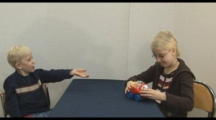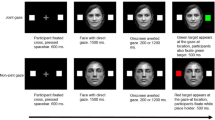Abstract
Observing eye contact between others enhances the tendency to subsequently follow their gaze and has been suggested to function as a social signal that adds meaning to an upcoming action or event. The present study investigated effects of observed eye contact in high-functioning autism (HFA). Two faces on a screen either looked at or away from each other before providing congruent or incongruent gaze cues to one of two target locations. In contrast to control participants, HFA participants did not depict enhanced gaze following after observing eye contact. Individuals with autism, hence, do not seem to process observed mutual gaze as a social signal indicating the relevance of upcoming (gaze) behaviour. This may be based on the reduced tendency of individuals with HFA to engage in social gaze behavior themselves, and might underlie some of the characteristic deficiencies in social communicative behaviour in autism.


Similar content being viewed by others
Notes
Note that the term ‘observed eye contact’ refers to the observation of eye contact between other agents (not the experience of being looked at oneself).
The control group entailed numerically more women than the HFA group and there are indications of larger gaze cueing effects in women (Bayliss et al. 2005). Though the HFA and control group did not differ significantly in terms of age and gender, both variables were included as covariates in additional analyses. Results revealed no interactions of Gender with any of the other factors or with any of the interactions [Fs(1, 50) ≤ 1.9, p ≥ .16, η2 ≤ 0.038] and no effect of Age with any of the factors or interactions [Fs(1, 50) < 1].
It needs to be mentioned that the condition in which the two faces are looking at each other, as opposed to looking away, constitutes a situation in which (a) participants’ attention is drawn to the centre of the screen and (b) the two faces are looking at something together with the participant. Control experiments in the original paper suggest that the enhanced gaze cueing effect after observing direct gaze is not due to either of these potential confounds. Enhanced gaze following was not found when participants’ attention was directed towards the center by non-social cues or when one face looked at an object before providing gaze cues (Böckler et al., 2011).
References
Bakeman, R., & Adamson, L. (1984). Coordinating attention to people and objects in mother–infant and peer–infant interaction. Child Development, 55, 1278–1289.
Baldwin, D. (1995). Understanding the link between joint attention and language. In C. Moore & P. Dunham (Eds.), Joint attention: Its origins and role in development (pp. 131–158). Hillsdale, NJ: Erlbaum.
Baron-Cohen, S. (1989). Joint-attention deficits in autism: Towards a cognitive analysis. Developmental Psychopathology, 3, 185–189.
Baron-Cohen, S. (1991). Precursors to a theory of mind: Understanding attention in others. In A. Whiten (Ed.), Natural theories of mind: Evolution, development and simulation of everyday mindreading (pp. 233–251). Oxford: Basil Blackwell.
Baron-Cohen, S. (1995). Mindblindness: An essay on autism and theory of mind. Massachusetts: MIT Press.
Baron-Cohen, S. (2003). The essential difference: The truth about the male and female brain. New York, NY: Basic Books.
Baron-Cohen, S., Tager-Flusberg, H., & Cohen, D. (2000). Understanding other minds: Perspectives from developmental neuroscience. Oxford: Oxford University Press.
Barresi, J., & Moore, C. (1996). Intentional relations and social understanding. Behavioral and Brain Sciences, 19, 107–154.
Bayliss, A. P., di Pellegrino, G., & Tipper, S. P. (2005). Sex differences in eye gaze and symbolic cueing of attention. The Quarterly Journal of Experimental Psychology, 58, 631–650.
Beck, A. T., & Steer, R. A. (1987). Beck depression inventory-manual. San Antonio: The Psychological Corporation.
Böckler, A., Knoblich, G., & Sebanz, N. (2011). Observing shared attention modulates gaze following. Cognition, 120, 292–298.
Bölte, S., Holtmann, M., Poustka, F., Scheurich, A., & Schmidt, L. (2007). Gestalt perception and local-global processing in high-functioning autism. Journal of Autism and Developmental Disorders, 37, 1493–1504.
Bristow, D., Rees, G., & Frith, C. D. (2007). Social interaction modifies neural responses to gaze shifts. Social Cognitive and Affective Neuroscience, 2, 52–61.
Carhart-Harris, R. L., & Friston, K. J. (2010). The default-mode, ego-functions and free-energy: A neurobiological account of Freudian ideas. Brain, 133, 1265–1283.
Chawarska, K., Klin, A., & Volkmar, F. (2003). Automatic attention cueing through eye movement in 2 year old children with autism. Child Development, 74, 1108–1123.
Chevallier, C., Kohls, G., Troiani, V., Brodkin, E. S., & Schultz, R. T. (2012). The social motivation theory of autism. Trends in Cognitive Sciences,. doi:10.1016/j.tics.2012.02.007.
Clark, A. (2013). Whatever next? Predictive brains, situated agents, and the future of cognitive science. Behavioral and Brain Sciences, 36, 181–204.
Clark, H. H., & Krych, M. A. (2004). Speaking while monitoring addressees for understanding. Journal of Memory and Language, 50, 62–81.
Csibra, G. (2010). Recognizing communicative intentions in infancy. Mind and Language, 25, 141–168.
Csibra, G., & Gergely, G. (2009). Natural pedagogy. Trends in Cognitive Sciences, 13, 148–153.
Driver, J., Davis, G., Ricciardelli, P., Kidd, P., Maxwell, E., & Baron-Cohen, S. (1999). Gaze perception triggers reflexive visuospatial orienting. Visual Cognition, 6, 509–540.
Farroni, T., Csibra, G., Simion, F., & Johnson, M. H. (2002). Eye contact detection at birth. Proceedings of the National Academy of Sciences, 99(14), 9602–9605.
Friesen, C. K., & Kingstone, A. (1998). The eyes have it! Reflexive orienting is triggered by nonpredictive gaze. Psychonomic Bulletin & Review, 5, 490–495.
Greene, D., Colich, N., Iacoboni, M., Zaidel, E., Bookheimer, S. Y., & Dapretto, M. (2011). Atypical neural networks for social orienting in autism spectrum disorders. Neuroimage, 56(1), 354–362.
Ham, J., & Tronick, E. Z. (2006). Infant resilience to the stress of the still-face. Annals New York Academy of Science, 1094, 297–302.
Happé, F. G. E. (1993). Communicative competence and theory of mind in autism: A test of relevance theory. Cognition, 48, 101–119.
Hill, E. L., & Frith, U. (2003). Understanding autism: Insights from mind and brain. Philosophical Transactions of the Royal Society, Biological Sciences, 358, 281–289.
Kuzmanovic, B., Schilbach, L., Lehnhardt, F. G., Bente, G., & Vogeley, K. (2011). A matter of words: Impact of verbal and nonverbal information on impression formation in high-functioning autism. Research in Autism Spectrum Disorders, 5(1), 604–613.
Kylliäinen, A., & Hietanen, J. K. (2004). Attention orienting by another’s gaze direction in children with autism. Journal of Child Psychology and Psychiatry, 44, 435–444.
Kylliäinen, A., & Hietanen, J. K. (2006). Skin conductance response to another person’s gaze in children with autism. Journal of Autism and Developmental Disorders, 36, 517–525.
Loftus, G. R., & Masson, M. E. J. (1994). Using confidence intervals in within-subject designs. Psychonomic Bulletin & Review, 1, 476–490.
Mundy, P. (2003). Annotation: The neural basis of social impairments in autism: The role of the dorsal medial-frontal cortex and anterior cingulate system. Journal of Child Psychology and Psychiatry, 44, 793–809.
Mundy, P., Block, J., Delgado, C., Pomares, Y., Van Hecke, V. A., & Parlade, M. V. (2007). Individual differences and the development of joint attention in infancy. Child Development, 78, 938–954.
Mundy, P., Sigman, M., & Kasari, C. (1994). Joint attention, developmental level, and symptom presentation in autism. Development and Psychopathology, 6, 389–401.
Nation, K., & Penny, S. (2008). Sensitivity to eye gaze in autism: Is it normal? Is it automatic? Is it social? Development and Psychopathology, 20, 79–97.
Pierno, A. C., Becchio, C., Wall, M. B., Smith, A. T., Turella, L., & Castiello, U. (2006). When gaze turns into grasp. Journal of Cognitive Neuroscience, 18, 2130–2137.
Reddy, V. (2003). On being the object of attention: Implications for self-other consciousness. Trends in Cognitive Sciences, 7(9), 397–402.
Richardson, D. C., & Dale, R. (2005). Looking to understand: The coupling between speakers’ and listeners’ eye movements and its relationship to discourse comprehension. Cognitive Science: A Multidisciplinary Journal, 29, 1045–1060.
Schilbach, L. (2010). A second-person approach to other minds. Nature Reviews Neuroscience, 11(6), 449.
Schilbach, L., Bzdok, D., Timmermans, B., Fox, P. T., Laird, A. R., Vogeley, K., & Eickhoff, S. B. (2012). Introspective minds: Using ALE metaanalyses to study commonalities in the neural correlates of emotional processing, social and unconstrained cognition. PLoS One.
Schilbach, L., Eickhoff, S. B., Cieslik, E. C., Kuzmanovic, B., & Vogeley, K. (2011). Shall we do this together? Social gaze influences action control in a comparison group, but not in individuals with highfunctioning autism. Autism,. doi:10.1177/1362361311409258.
Schilbach, L., Eickhoff, S. B., Cieslik, E., Shah, N. J., Fink, G. R., & Vogeley, K. (2010a). Eyes on me: An fMRI study of the effects of social gaze on action control. Social Cognitive and Affective Neuroscience, 6(4), 393–403.
Schilbach, L., Timmermans, B., Reddy, V., Costall, A., Bente, G., Schlicht, T., & Vogeley, K. (2013). Towards a second-person neuroscience. Behavioral and Brain Sciences, 36(4), 393–414.
Schilbach, L., Wilms, M., Eickhoff, S. B., Romanzetti, S., Tepest, R., Bente, G., et al. (2010b). Minds made for sharing: Initiating joint attention recruits reward-related neurocircuitry. Journal of Cognitive Neuroscience, 22(12), 2702–2715.
Sebanz, N., Bekkering, H., & Knoblich, G. (2006). Joint action: Bodies and minds moving together. Trends in Cognitive Sciences, 10, 70–76.
Sebanz, N., Knoblich, G., Stumpf, L., & Prinz, W. (2005). Far from action blind: Representation of others’ actions in individuals with autism. Cognitive Neuropsychology, 22, 433–454.
Senju, A., & Csibra, G. (2008). Gaze following in human infants depends on communicative signals. Current Biology, 18, 668–671.
Sigman, M., & Ruskin, E. (1999). Continuity and change in the social competence of children with autism, Down syndrome, and developmental delays. Monographs of the Society for Research in Child Development, 64, 1–113.
Speer, L. L., Cook, A. E., McMahon, W. M., & Clark, E. (2007). Face processing in children with autism: Effects of stimulus contents and type. Autism, 11, 265–277.
Stewart, M. E., Barnard, L., Pearson, J., Hasan, R., & O’Brien, G. (2006). Presentation of depression in autism and Asperger syndrome: A review. Autism, 10, 103–116.
Striano, T., Reid, V. M., & Hoehl, S. (2006). Neural mechanisms of joint attention in infancy. European Journal of Neuroscience, 23, 2819–2823.
Timmermans, B., Schilbach, L., Pasquali, A., & Cleeremans, A. (2012). Higher-order thoughts in action: Consciousness as an unconscious re-description process. Philosophical Transactions of the Royal Society B, 367, 1412–1423.
Tomasello, M., & Carpenter, M. (2007). Shared intentionality. Developmental Science, 10, 121–125.
Tomasello, M., Carpenter, M., Call, J., Behne, T., & Moll, H. (2005). Understanding and sharing intentions: The origins of cultural cognition. Behavioral and Brain Sciences, 28, 675–691.
Wang, Y., Newport, R., & de Hamilton, A. F. (2010). Eye contact enhances mimicry of intransitive hand movements. Biology Letters,. doi:10.1098/rsbl.2010.0279.
Wheelwright, S., Baron-Cohen, S., Goldenfeld, N., Delaney, J., Fine, D., Smith, R., et al. (2006). Predicting autism spectrum quotient (AQ) from the systemizing quotient-revised (SQ-R) and empathy quotient (EQ). Brain Research, 1079, 47–56.
Yoon, J. M. D., Johnson, M. H., & Csibra, G. (2008). Communication-induced memory biases in preverbal infants. Proceedings of the National Academy of Sciences of the United States of America, 105, 13690–13695.
Zwickel, J., White, S. J., Coniston, D., Senju, A., & Frith, U. (2010). Exploring the building blocks of social cognition: Spontaneous agency perception and visual perspective taking in autism. Social Cognitive and Affective Neuroscience, 6, 564–571.
Acknowledgments
This research was supported by grants from the Volkswagen Foundation (K.V., L.S.), the Köln Fortune Program of the Medical Faculty at the University of Cologne (L.S.) and the European Science Foundation (A.B., N.S.). We thank Tabea van der Lühe for her assistance with recruitment and testing of the participants with HFA in Cologne and for her help with data administration. We are very thankful to Anne Blankenhorn for her help with recruiting and testing the control participants in Nijmegen and for analyzing and administrating the questionnaires.
Author information
Authors and Affiliations
Corresponding author
Rights and permissions
About this article
Cite this article
Böckler, A., Timmermans, B., Sebanz, N. et al. Effects of Observing Eye Contact on Gaze Following in High-Functioning Autism. J Autism Dev Disord 44, 1651–1658 (2014). https://doi.org/10.1007/s10803-014-2038-5
Published:
Issue Date:
DOI: https://doi.org/10.1007/s10803-014-2038-5




